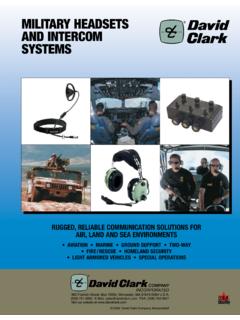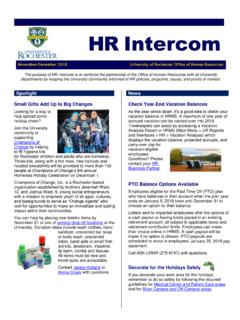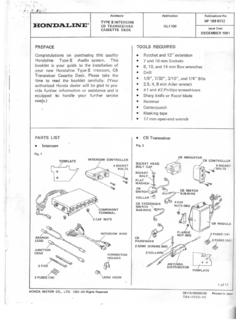Transcription of Museums for visitors: Audience development - A ... - Intercom
1 Museums for visitors : Audience development - A crucial role for successful museum management strategiesChristian WALTLA bstractLet's face it: Museums without visitors would be like lifeless, empty halls with no should remind us that the key role for Museums is always to serve its visitors . To do thiseffectively and efficiently we have to understand the motivation and needs of different audiencesegments and create an atmosphere that offers a range of experiences. It is all about pullingdown barriers and allowing visitor involvement and engagement, and at the same timeconserving and securing the collection for future generations. The process of reaching newaudiences and retaining repeat visitors is called Audience development . It is the perfect Zusammenspiel of departments such as marketing, education, curatorial and visitor servicesto offer varied experiences, and an environment for learning as well as enjoyment.
2 Museumswith space for recreation, social interaction, contemplation and emotions are high on theagenda these days. The talk will explore the term Audience development theoretically, itsimportance for management strategy, and highlight examples of work with different audiencesegments. It will also show that Audience development is not the responsibility of only a few, butof all staff working in Museums . 1 Intercom 2006 Conference PaperMuseums for visitors : Audience development - A crucial role for successful museum management strategiesIntroductionMuseums have entered a time of change:they are asked not only to justify their fundingbut also to redefine their role in halls, real objects or comprehensiveexhibitions do need visitor engagement inorder to be rightfully called Museums caringfor our culture and for future substantial public funding museumssurvival is by no means guaranteed; an activedialogue with potential and existingaudiences and special interest groups is alsonecessary.
3 In a consultation paper in 2005the UK government states that Museums andgalleries play an essential role in helping itscitizens to understand their place in the worldand its heritage and that they connect ourpast with our present and our future . 1 Stephen Weil argues that a museum, .. isstill nothing more than a human fabrication,an organisational contrivance through whichsome group or other hopes to achieve someshort or long-term objective. Whateverworthiness a museum may ultimately havederives from what it does, not from what it is 2. In Austria today we see also a slight shift,in some cases a substantial shift, in the roleof Museums away from the main corefunctions such as collecting, documenting,preserving and research towards a visitororientatedapproach. That is not to say thatthe core functions are no longer important butthey need to be assessed in the context ofwhat Museums are all about.
4 Even ICOM inits 2002 rewritten Code of Ethics sees amuseum as a social space and defines amuseum as: .. a non-profit makingpermanent institution in the service of societyand of its development , open to the public,which acquires, conserves, researches,communicates and exhibits, for purpose ofstudy, education and enjoyment, the tangibleand intangible evidence of people and theirenvironment .3 Museum for the manyMuseums are centres of knowledge andthe mission to offer an educationalexperience is the key objective in serving ourvisitors. It is interesting to note that researchin the US and UK shows that it is not thequality of the collection which is the mainfactor for potential visitors when deciding tovisit a museum or gallery, it is much more theenvironment as a whole and the interactionwith the collection that proves to be the keyfactor.
5 It is very much about offeringopportunities for engagement. This alsomeans that Museums are part of the serviceindustry working in partnership with allstakeholders to achieve user satisfaction at atime when expectations on service qualitygenerally are rising. According to Pine andGilmore the desirable economic products areleisure experiences which are more highlyvalued rather then merely services orproducts. 4It is not the question of learningversus entertainment it is a win-winphenomenon where both construct anexperience that is engaging people ineducationally enjoyable experiences fromwhich they can take their own personalmeaning .5 The process of establishing Museums forthe many goes hand in hand with atransformation of Museums which engageand involve visitors and change from being product led to Audience centered.
6 6 Ifmuseums are able to engage the visitor in acommunication process so that the visitor isable to relate to his or her experiences, Museums have to become more open and1 Understanding the Future: Museums and 21st. CenturyLife, DCMS, Weil, Beyond Management: Making MuseumsMatter in Intercom , Study Series, No12, 2006, code of ethics for Museums , ICOM, Paris & Gilmore, 1999, The experience economy: Workis Theatre and every business a stage, Boston, & Dierking, 2000, Learning from Museums , p76. 6 Black Graham, 2005, The Engaging Museums for Visitor involvement, p3. 2 Intercom 2006 Conference Papermore accessible - better meeting visitorneeds and achieving greater visitorsatisfaction. An Audience -focused museumhas a dynamic relationship between theprogramme activities and the Audience .
7 Some of these changes are hugelydebated and Museums are often criticised for dumbing down but with the commitment ofproviding innovative programmes with thehighest possible quality standard for a widerange of audiences, Museums can establishthemselves as centres of excellence, show-casting original objects which make a positivedifference to people's lives. Having said that,it all depends on getting more people moreoften through the door and convince themwith exciting programmes and challengingexhibitions that a museum visit can offer notonly educational experiences second to none,but is also fun and developmentAudience development is very much anAnglo-American led term, which has onlyslowly found its way into Central Europe thatdescribes a powerful process of improvingservices to existing visitors and reaching outto new audiences.
8 It is not a simple course ofaction but a planned and targetedmanagement process which involves almostall areas of a museum working together todeliver the organisation's overall aims andobjectives to high quality standards. For HansChristian Anderson Audience developmentmeans enriching the experience of yourvisitors by helping them to learn more anddeepening their enjoyment of what you haveto offer. It therefore combines the aims of thecurator, educator and marketer. 7 Audiencedevelopment also needs to ensure thatmuseums continue to be relevant to all thedifferent community groups. Thus the coreelements of Audience development are Theactions we take to involve people, tounderstand their needs and interests, and tocreate an environment and experience thatappeals to them. 8 Audience development is about breakingdown barriers in all its forms and shapes andengaging visitors in activities which theyconsider worthwhile.
9 It is not only aboutnumbers, and there are different approachesdepending on the need of the specific targetgroup. The basis of all audiencedevelopment initiatives should be research -market research - knowing your Audience iskey to identify different needs but also todevelop niche markets and convince morevisitors to become regular museum argues that successful Museums needto provide multiple experiences: aestheticand emotional delight, celebration andlearning, recreation and sociability .9 Indelivering multiple experiences that aresatisfying and engaging Museums will meetspecific needs of different target groups andalso help individual audiences in their self- development process. Diagram 1: Audience development Model ( C. Waltl) Successful Audience development is theperfect Zusammenspiel of almost allmuseum departments.
10 In this model researchand collections are core to be able to devisea programme that is communicated throughinterpretation and marketing. Together they7 Anderson Hans Christian, Museums development Plan, Heritage Lottery Fund,UK, and Kotler (1998: 39).c 3 Intercom 2006 Conference Paperbring the message across to the visitors andpotential visitors . Goals of a sustainable AudienceDevelopment strategy are: To refine and enhance communication withvisitors To achieve an attainable and sustainableaudience To turn non visitors into visitors , visitors intorepeat visitors and regular museum goersinto supporters To enhance access To offer multiple experiences To engage visitors (hands on & minds on) To establish an active network with specialtarget your audienceBeing Audience -centred rather thanproduct-led requires a profoundunderstanding of visitors and non- visitors withrespect to their nature, motivations,expectations and needs.






